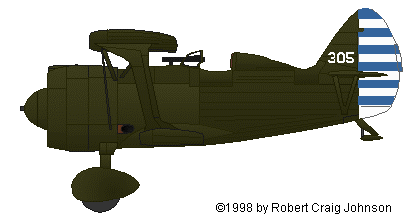Review:
Encore's 1/72-scale Polikarpov I-15bis
Encore Models, Kit 1025.
47 parts on 2 sprues, detailed interior,
decals for 3 aircraft. $9.95
This little biplane is easily one of the most satisfactory model kits we have seen for some time.
Molded in the Ukraine in the soft, low-pressure injected plastic typical of products originating inside the former
Soviet Union, the kit consists of 47 parts on 2 odd, half-round sprues plus a tiny canopy packed in a small manila envelope.
First impressions are anything but promising with this kit. The parts come out of their plastic bag coated with
some sort of thick, greasy goo that emits a strong chemical smell. Is this Russian petroleum jelly used as mold release in some
Ukrainian home-molding shop?  Or is it a novel and sinister way
of disposing of toxic industrial waste? Be that as it may, the stuff is tenacious.
After several soaks in strong detergent made no difference, I sealed the sprues up in a large plastic bag of denatured alcohol
and left it for a week, agitating it from time to time. This finally did the trick.
Or is it a novel and sinister way
of disposing of toxic industrial waste? Be that as it may, the stuff is tenacious.
After several soaks in strong detergent made no difference, I sealed the sprues up in a large plastic bag of denatured alcohol
and left it for a week, agitating it from time to time. This finally did the trick.
Freed from the grease, the kit makes a much better impression. The parts suffer relatively little from
flash and are incredibly finely molded, particularly for a product of low-pressure injection. Detail is exceptionally
good for a small-scale kit. You get a separate if basic radial engine, molded in cockpit sidewall-detail, a seat, rudder
pedals, an instrument panel, a gun sight, and a delicately molded set of parts for the tubular fuselage structure
surrounding the cockpit, complete with throttle quadrants. Surface detail includes a mix of engraved and raised features. The
metal leading edges of the wings and the ribbing of the fabric-covered portions of the flying surfaces are done in subtle and
thoroughly convincing fashion. Gun muzzles, intakes, and exhaust pipes are molded solid, but you can easily drill them out.
Assembly is straightforward, despite the lack of locating pins, and fit is simply superb. No filler was necessary, even
around the geometrically complicated joint between the lower wing and the fuselage (a real trouble spot in Heller's
conceptually similar I-153). The sharply raked and canted interplane struts butt up against prominent fairings
molded into the wings. But these fit perfectly.
The cabane struts are another matter, however. They are far too tall for the gap between the wing and fuselage.
To make matters worse, the fuselage reveals few hints as to the correct location of the struts. Deal with this problem
as follows.
- Assemble the model except for the top wing, and struts, and landing gear
- Cement the interplane struts to the upper wing.
- Align the interplane struts by dry-fitting the assembly to the lower wing. Tape it in place until the cement has set.
- Using photographs (such as those found in Squadron/Signal's Polikarpov Fighters in Action, Part 1) as a reference,
drill locating holes for the N-type cabane in the fuselage top decking.
- Enlarge the holes where the diagonal of the "N" meets the forward upright. Open them out into a longitudinal slot large
enough to let you push the N-strut down into the fuselage. Remember to angle the holes enough to give the struts the
correct angle.
- Working quickly, cement the N-shaped cabane struts to the fuselage, and push them down to the approximate height of the
center section. Then cement the lower ends of the interplane struts to the lower wing, and tape in place.
- Using forceps or a probe, adjust the cabane struts until they meet the under surface of the upper wing and cement.
The landing gear is the only other potential trouble area. The legs have a slender, convincingly scale appearance, but
the plain butt joint between the wheel pants and the suspension leg is consequently weak. You can correct this by drilling holes
and inserting brass wire pegs, fixed in place with cyanoacrylate superglue.
Encore supplies its usual generous assortment of high-quality decals. This version of the kit includes a Russian aircraft in
segment camouflage, from a Baltic Fleet IAP, a captured sand-and-olive camouflaged Spanish Nationalist example, and an overall
olive-drab Chinese airplane. The kit is also available with a ski landing gear and decals for Russian and Finnish machines.
This kit took a scant two afternoons to complete.
Highly recommended.
Text and illustrations © 1998 by Robert Craig Johnson
 Or is it a novel and sinister way
of disposing of toxic industrial waste? Be that as it may, the stuff is tenacious.
After several soaks in strong detergent made no difference, I sealed the sprues up in a large plastic bag of denatured alcohol
and left it for a week, agitating it from time to time. This finally did the trick.
Or is it a novel and sinister way
of disposing of toxic industrial waste? Be that as it may, the stuff is tenacious.
After several soaks in strong detergent made no difference, I sealed the sprues up in a large plastic bag of denatured alcohol
and left it for a week, agitating it from time to time. This finally did the trick.